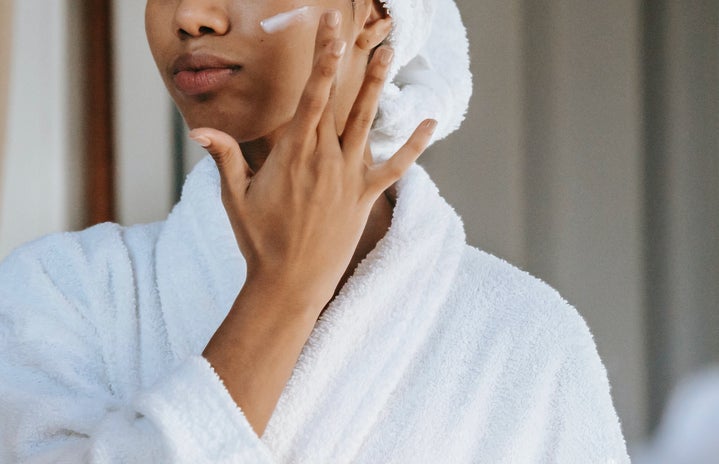Welcome back my baby skin-case enthusiasts! Now that we’ve established your basic skin-care routine (washing 2x a day, moisturizer, and sunscreen), I think it’s time we add some active ingredients! Active ingredients work to serve very specific needs of your skin, and can be implemented to improve the appearance and texture of your skin.
Please proceed with caution, though. Perform a patch test for every new product you introduce to your routine, because ultimately, you don’t know how your skin is going to react. Furthermore, you should already be using sunscreen, but if you’re going to be using any active ingredients, this becomes so much more important. Without sunscreen, your skin is vulnerable to the harmful UV rays which will degrade and potentially worsen the effects of any active ingredients that you put on your skin!! It’s awful, really, so please use sunscreen.
When in doubt, I’d recommend consulting the Paula’s Choice ingredient dictionary. They have nearly every ingredient you’d find in a skin-care product and give a comprehensive definition and usage for each.
- The Non-Actives
-
I know. Non-actives sounds a little contrary to what I said I was going to be talking about. However, I want to spend a little time highlighting some ingredients that are beneficial in tandem to some actives, as well on their own. Starting off, we have good ‘ol hyaluronic acid. If you’re not on #Skintok on TikTok, you might not be aware of this wonderful ingredient, so let me shed some light. Hyaluronic acid is a hydrating molecule naturally found in our skin, and when applied topically, rehydrates your skin by absorbing 50x its weight in water. It’s crucial that you apply this to damp skin, else it will just dehydrate your skin.
Alongside hyaluronic acid, niacinamide is a beautiful antioxidant that regulates oil production, improves skin texture and appearance, and reduces the appearance of enlarged pores. Both of these items are available over the counter and rather inexpensively, but if I’m being honest, if you can afford the more expensive versions (eg. Paula’s Choice Hyaluronic Acid Booster vs The Ordinary Hyaluronic Acid +B5), you should make the splurge. It’s not that the more inexpensive solutions are bad, it’s just that you will see significant more improvement with a serum that is formulated with better ingredients.
For both of these ingredients, you can use them during the day or the nighttime. Since niacinamide is an antioxidant, it can be more effective during the day, but either time (or both) would work.
- AHA’s/BHA’s
-
Welcome to the world of chemical exfoliants, my friends, please leave your apricot scrubs at the door. AHA’s (Alpha Hydroxy Acid) and BHA’s (Salicylic Acid) are wonderful, truly wonderful ingredients that I genuinely think everyone needs in their lives.
As with any exfoliant, AHA’s and BHA’s slough away at dead skin to reveal beautiful, brightened skin!
AHA’s are a bit more potent and therefore, can be irritating. Glycolic Acid is the smallest molecule size of these exfoliants, so they can bear results quicker, but can also irritate quicker. Lactic Acid on the other hand is a hydrating AHA, but isn’t as powerful as Glycolic Acid.
BHA’s really just stand for Salicylic Acid, but it’s okay, because Salicylic Acid is truly that girl. It’s oil soluble, whereas AHA’s are water soluble, so it’s able to penetrate deeper into the skin and unclog your pores.
It’s recommended that you use these ingredients at night, as they can increase your skin’s sensitivity to the sun.
- Retinols
-
First and very foremost, do not, under any circumstances, use retinol with any other active ingredient (unless it’s formulated with another active ingredient). It will not go well for you.
Retinols (or Retinoids) are a derivative of Vitamin A which works to increase your cell turnover. As a result, wrinkles and fine lines will begin to disappear, acne marks will fade, and acne will go away! It’s recommended that you start a form of retinol when you enter your 20s as a preventative to wrinkles and fine lines.
There are several over the counter retinols that are available, but the best retinols you will find are prescription-strength. Yes, I’m talking about tretinoin. Tretinoin is another cult-classic, and I love it. Tretinoin is the purest form of Vitamin A that is applied topically. It can be very irritating, so it’s important to slowly incorporate it into your daily routine (Start with 1x a week for 1 week, 2x for 2 weeks and so forth).
If you can’t get your hands on tretinoin, Differin (with adapalene) is super beneficial, and available over the counter.
Retinols are a bit more complicated than any of the other active ingredients I’ve mentioned, so I really do recommend reading some other sources about this to get a better understanding of how to use it (See: r/tretinoin on Reddit). Also, if you have sensitive skin, granactive retinoids might be more your speed since they are less irritating for your skin!
Retinols should *always* be used at night.
- Vitamin C
-
For those of you who didn’t start using a Vitamin C serum at age 12, please, let me introduce you to a cult-classic antioxidant that is supposed to brighten skin, fade dark spots, and reverse the signs of aging.
And to be honest, this is a cult classic that I’m over. At least, if you’re at least slightly melanin-blessed, Vitamin C just doesn’t do it for us. Instead, I’d recommend an Azelaic Acid or Mandelic Acid booster to achieve the same brightening and clarifying effect.
But, for the rest of you baddies…tread carefully. Vitamin C is a really difficult formula to keep and be effective because of its naturally unstable formulation. Vitamin C can be irritating if you aren’t careful.
For this ingredient, I would not recommend buying an inexpensive product, it’s just not worth it. You need a product that will prevent oxidation (so droppers are a big no-no!), and is formulated to minimize irritation.
However!!!! If your skin likes Vitamin C, please don’t let me stop you. There’s a reason this is a cult classic, and maybe this brightening, toning antioxidant is just what you need.
5. Benzoyl Peroxide/Clindamycin
These two ingredients are typically used to treat acne, and are often used together. Benzoyl Peroxide is a topical antiseptic that kills acne-causing bacteria. This treatment should be used as a spot treatment, and not incredibly layered, as it can dry out skin. Similarly, clindamycin is a topical antibiotic that slows the growth of acne-causing bacteria. This ingredient is less drying than benzoyl peroxide, but is less accessible to the general public.
As always, I’d recommend doing your own research prior to implementing any of these ingredients. *I* do not know your skin, but you do! Make choices that are smart for your skin, not because something is trending and you wanna just try it out. Trying out skin-care is not like trying on clothes. If you try something that your skin really doesn’t like, you can cause a lot of damage. If you’re really worried about using a particular product, you should consult an esthetician or dermatologist, and maybe the internet if you’re feeling trusting.
I would also like to say that while I might’ve compiled this information for you, this wouldn’t have been possible without the research and posts done by several estheticians I follow on Twitter and Instagram. They’re all wonderful, super educated people, and if you need any more skin-care advice, I’d recommend following them on Twitter: Nai @/labeautyologist, Ashley @/skinclasshhero, Lily @/caveofbeauty, and Sean @/seangarette.


